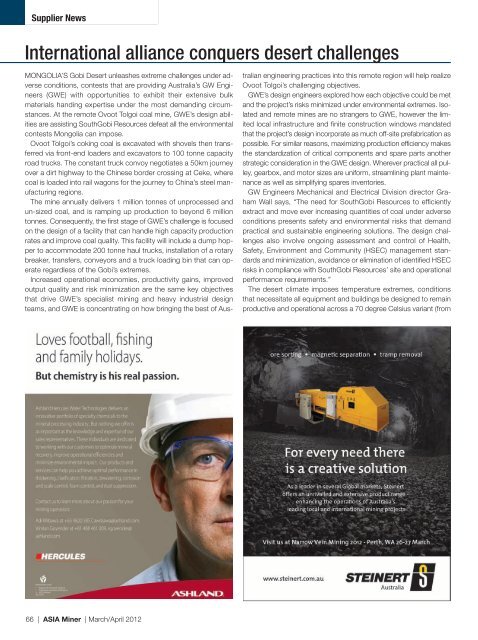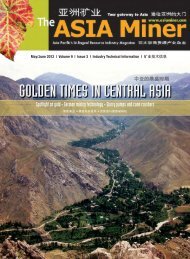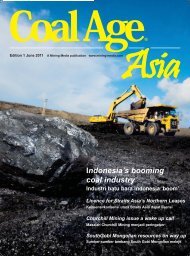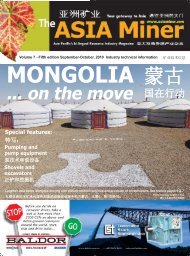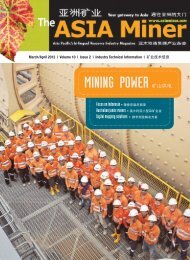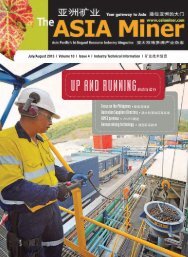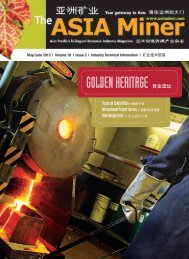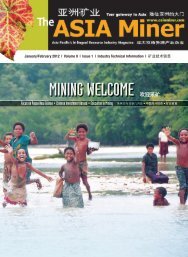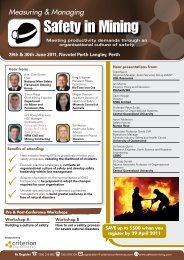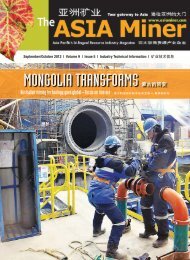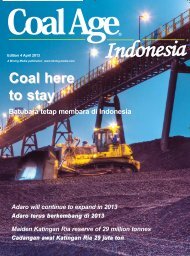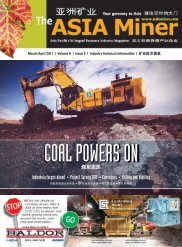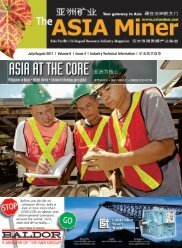Volume 9 Edition 2 2012 - The ASIA Miner
Volume 9 Edition 2 2012 - The ASIA Miner
Volume 9 Edition 2 2012 - The ASIA Miner
Create successful ePaper yourself
Turn your PDF publications into a flip-book with our unique Google optimized e-Paper software.
Supplier News<br />
International alliance conquers desert challenges<br />
MONGOLIA’S Gobi Desert unleashes extreme challenges under adverse<br />
conditions, contests that are providing Australia’s GW Engineers<br />
(GWE) with opportunities to exhibit their extensive bulk<br />
materials handing expertise under the most demanding circumstances.<br />
At the remote Ovoot Tolgoi coal mine, GWE’s design abilities<br />
are assisting SouthGobi Resources defeat all the environmental<br />
contests Mongolia can impose.<br />
Ovoot Tolgoi’s coking coal is excavated with shovels then transferred<br />
via front-end loaders and excavators to 100 tonne capacity<br />
road trucks. <strong>The</strong> constant truck convoy negotiates a 50km journey<br />
over a dirt highway to the Chinese border crossing at Ceke, where<br />
coal is loaded into rail wagons for the journey to China’s steel manufacturing<br />
regions.<br />
<strong>The</strong> mine annually delivers 1 million tonnes of unprocessed and<br />
un-sized coal, and is ramping up production to beyond 6 million<br />
tonnes. Consequently, the first stage of GWE’s challenge is focused<br />
on the design of a facility that can handle high capacity production<br />
rates and improve coal quality. This facility will include a dump hopper<br />
to accommodate 200 tonne haul trucks, installation of a rotary<br />
breaker, transfers, conveyors and a truck loading bin that can operate<br />
regardless of the Gobi’s extremes.<br />
Increased operational economies, productivity gains, improved<br />
output quality and risk minimization are the same key objectives<br />
that drive GWE’s specialist mining and heavy industrial design<br />
teams, and GWE is concentrating on how bringing the best of Australian<br />
engineering practices into this remote region will help realize<br />
Ovoot Tolgoi’s challenging objectives.<br />
GWE’s design engineers explored how each objective could be met<br />
and the project’s risks minimized under environmental extremes. Isolated<br />
and remote mines are no strangers to GWE, however the limited<br />
local infrastructure and finite construction windows mandated<br />
that the project’s design incorporate as much off-site prefabrication as<br />
possible. For similar reasons, maximizing production efficiency makes<br />
the standardization of critical components and spare parts another<br />
strategic consideration in the GWE design. Wherever practical all pulley,<br />
gearbox, and motor sizes are uniform, streamlining plant maintenance<br />
as well as simplifying spares inventories.<br />
GW Engineers Mechanical and Electrical Division director Graham<br />
Wall says, “<strong>The</strong> need for SouthGobi Resources to efficiently<br />
extract and move ever increasing quantities of coal under adverse<br />
conditions presents safety and environmental risks that demand<br />
practical and sustainable engineering solutions. <strong>The</strong> design challenges<br />
also involve ongoing assessment and control of Health,<br />
Safety, Environment and Community (HSEC) management standards<br />
and minimization, avoidance or elimination of identified HSEC<br />
risks in compliance with SouthGobi Resources’ site and operational<br />
performance requirements.”<br />
<strong>The</strong> desert climate imposes temperature extremes, conditions<br />
that necessitate all equipment and buildings be designed to remain<br />
productive and operational across a 70 degree Celsius variant (from<br />
66 | <strong>ASIA</strong> <strong>Miner</strong> | March/April <strong>2012</strong>


